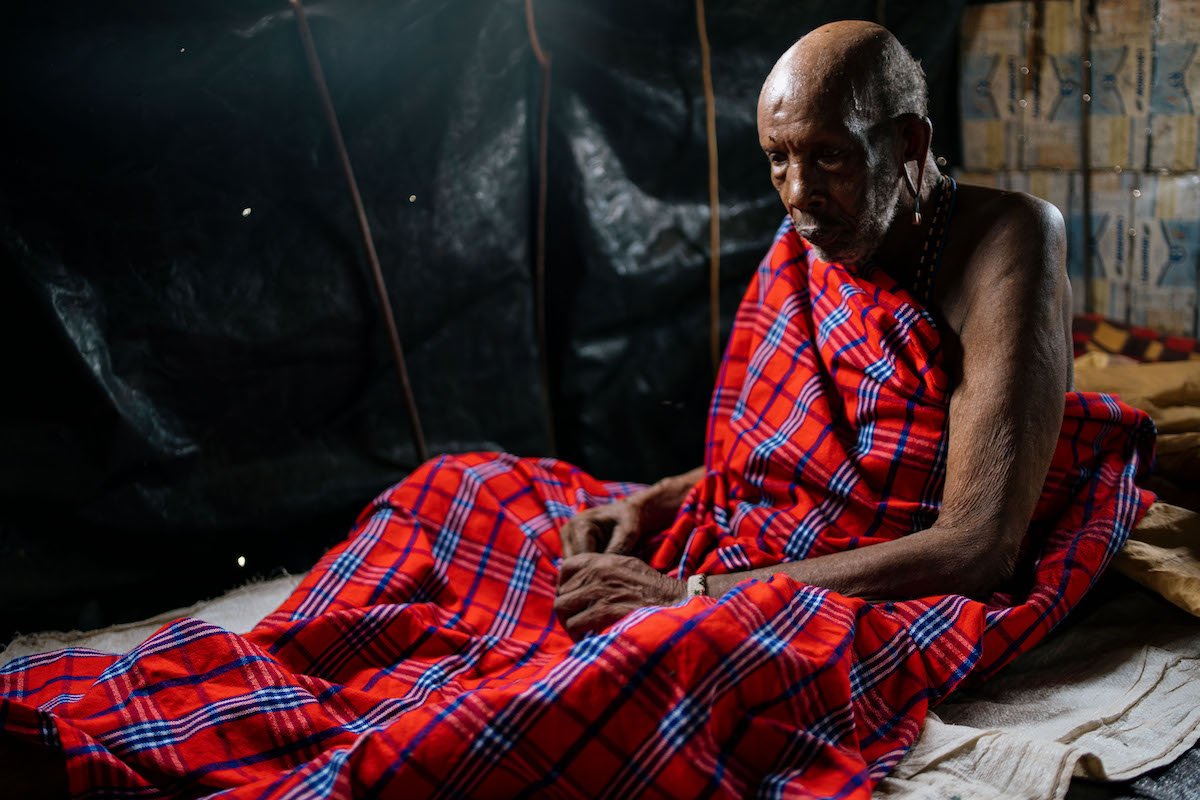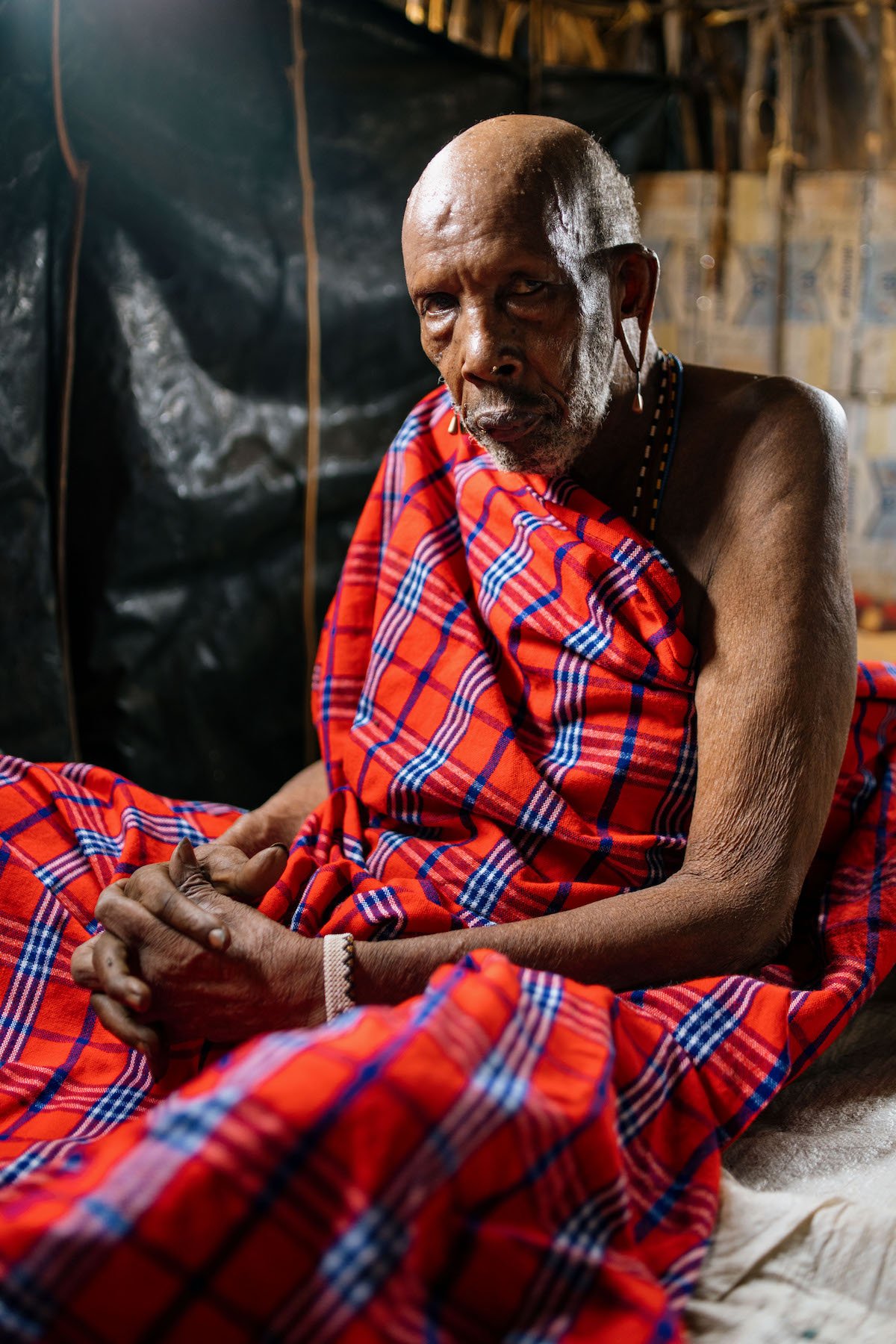Living history
Photo by Simon Pocock
Mzee Lemojong, the pioneering spirit behind Namunyak’s success.
In Samburu culture, elders are deeply respected, and as one of the last two remaining founding elders and board members of Namunyak Conservancy, Mzee Lemojong is described as a blessing to us all.
A stillness descends in the manyatta of one of Namunyak's most revered elders when he speaks, and the low hum among listeners goes quiet once his stories start to unfold. Surrounded by his children, grandchildren, and the mountains and plains that he loves, Mzee Lemojong slowly steps back in time as he unravels our history – and our world.
Humbled by his memories – and all he’s experienced to preserve the future of our people and the land we call home – his words are also a reminder of its rare beauty, and renewed inspiration to keep it thriving and whole.
As one of the last two remaining founding elders of Namunyak, Mzee Lemojong’s presence continues to fill the lengths and breadths of this landscape – and he has held its people and wildlife in his heart and hands throughout his life.
Photos by Simon Pocock
Pioneering a new future
Setting out three decades ago to safeguard the indigenous people and wildlife of Kenya’s northern frontier, the founding elders of Namunyak Community Conservancy faced a range of challenges while laying the foundations of a sustainable future for their people and their land.
Committed to preserving Samburu culture as well as these precious landscapes – while finding new ways forward – they opened the door for many opportunities, and ensured that a beautiful human-wildlife relationship that has lasted for centuries is still a profound part of their lives today.
Mzee Lemojong still remembers when he, Chairman Leshore, and 13 other Samburu elders formed Namunyak’s first Board of Trustees in 1995, aiming to protect it from outside poachers, grow a mixed economy including tourism and animal husbandry, and support the community while conserving this pristine wilderness.
As climate change had started to affect their pastoral existence – and the movement of livestock and wildlife – the elders understood the importance of supporting their people through alternative sources of livelihood, and focussing on the preservation of their environment.
Wanting to make the right decisions for the community as well as the land they call home, they travelled far and wide to find more information and expand their knowledge, and hear first-hand how a successful community conservancy would work. “We went to so many places to learn about conservation – and found people who gave us valuable advice that we could use,” says Mzee Lemojong.
Mzee Lemojong with one of his sons, who work at Reteti Elephant Sanctuary. He has 36 children. Photo by Simon Pocock.
No stone left unturned!
Spending considerable time in Kenya’s Maasai Mara National Reserve with the honourable Ole Ntutu (their former Paramount Chief), the elders asked for guidance on the establishment of a community conservancy. “Slaughtering several bulls for us to eat, they welcomed the Samburu community to Masaai land. After talking with them for a long time, we knew they gave us the right advice. We also speak the same Maa language and could believe in what they said.”
However, once the elders returned and shared their newfound knowledge back home, they were met with fierce resistance, and especially younger Samburu community members completely opposed their plans. Fearing that a conservancy would follow the model of a national park, they believed parts of Namunyak would be taken, turned into national reserves, and that the community would lose access to their ancestral land.
“There were a lot of uncertainties among our people,” remembers Mzee Lemojong, “so we had to explain the benefits of a community conservancy, and how it would work.”
Realising the need to reassure their people and educate the new generation on the possibilities of conservancies that are community owned, the elders embarked on a second journey to the Maasai Marai – and invited 30 young Samburu men along so that they too could hear more about community conservancies, and learn at the feet of the Paramount Chief Ole Ntutu and the advisers in his fold.
“We travelled to so many places to gather information and spent a lot of time in Tanzania to find out more about conservation too,” says Mzee Lemojong. “It helped us to create awareness among our people, and once they could see it would be good for the community, it became possible to open Sarara Camp, our first tourist lodge.”
Over time, the foundations laid by the founding elders bore significant fruit, and apart from helping to preserve this incredible wilderness and its wildlife, the conservancy has enabled them to generate alternative revenue for the community – which is used to educate their children, improve their healthcare and wellbeing, and ensure better access to sustainable resources like rangeland and water.
“I am happy and comfortable with the way things are now,” says Mzee Lemojong, “because we are seeing many benefits coming from the conservancy, and these are given to the community. This includes Reteti Elephant Sanctuary, which provides employment to keepers as well as the program selling goat milk.”
Namunyak Community Conservancy, surrounded by the Matthews Range. Photo by Simon Pocock.
Handing over the reins
“I’m growing very old now, and will be joining my ancestors soon,” says Mzee Lemojong, as he looks back on all that’s been achieved and considers the work that still needs to be done.
Cautioning all against mixing politics with conservation, he points out that it would “destroy us”. To inspire the next generation on the road ahead, his message is clear:
“We have played our part and have gone all over to make Namunyak stand. It’s your responsibility to take care of it now.”
While his memory may be fading due to age, and he may not recall everything that has happened during his life, Mzee Lemojong’s devotion to Namunyak and its history weaves into his hopes for its future – and it is a privilege to still hear him sharing his wisdom and insights based on his memories, commitment, and love for this land.
Our appreciation for Mzee Lemojong’s endless patience, wisdom, vision and guidance over many decades knows no bounds, and Namunyak will always be grateful for his enduring contribution to our livelihoods and incredible conservancy, which continues to this day.
* Namunyak was the first community conservancy formed in Samburu County in Kenya. It was established in 1995 by local communities living in the area to protect the region’s wildlife and wilderness while creating economic opportunities for the people who live there. Its democratically elected Board of Trustees is represented by the different areas that make up this 850,000-acre conservancy.





